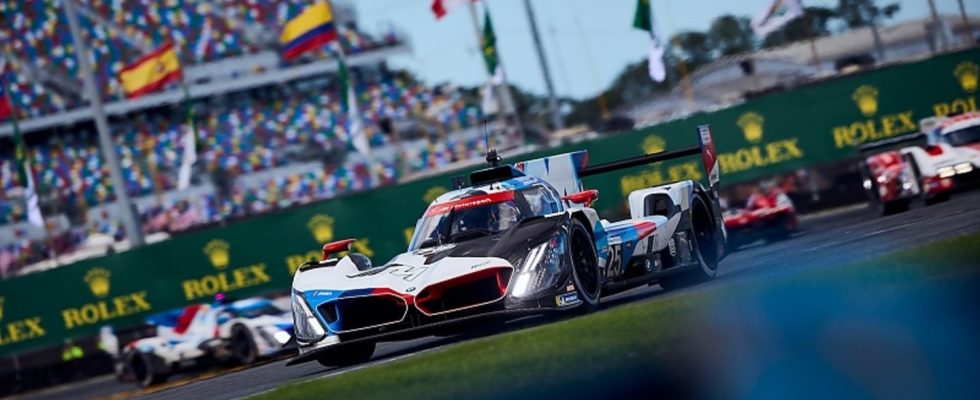Technology: What do Daytona, Dakar and Formula 1 bring to electromobility?
Racing labs
BMW M Hybrid V8
© press-inform – the press office
It was close and ultimately worked out. Audi took victory in the prestigious Dakar Rally at the third attempt – with an electric car. In addition, more and more manufacturers want to showcase themselves in the WEC endurance racing championship using partially electric vehicles. But what do these commitments bring for electromobility on the road?
Also in January, one of the most famous endurance races in the world ended with the 24 Hours of Daytona. The racing cars in the prototype class are also relying more than ever on an electric drive. The combustion engines are combined with a standard electric motor from Bosch. The total performance of the system: 519 kW / 706 HP with a racing weight of around one ton. The system works with a maximum voltage of 800 volts. The standard battery stores 1.35 kWh of usable energy, which can be accessed at any time during acceleration phases with boosts of 30 to 50 kilowatts. The new LMDh racing class generated great interest among car manufacturers due to its significantly lower costs and possible uses on all continents. Meanwhile, not only racing giants such as BMW, Porsche, Cadillac (General Motors) and Acura (Honda) are at the start with factory teams in the worldwide races, but Ferrari, Peugeot / Stellantis, Alpine / Renault and Lamborghini are also involved. Everyone is hoping for an image boost for electrified motorsport, after the Formula E racing series has attracted little interest, particularly in Europe.
Despite recent unsuccessful years, Mercedes continues to rely on Formula 1 and is now introducing the first technology modules into series cars for its AMG models. The best example is the Mercedes AMG SL 63 S E-Performance, which has the same drive package as the AMG S-Class or the GT four-door model. In all models, a four-liter eight-cylinder turbo delivers up to 600 kW / 816 hp and a gigantic torque of up to 1,420 Nm to both axles. This means that the open all-wheel drive vehicle can reach 100 km/h from a standstill in 2.9 seconds and the propulsion only ends at 317 km/h. The 450 kW / 612 hp eight-cylinder engine is combined with an electric drive on the rear axle, which consists of a 150 kW / 204 hp electric motor along with a two-speed transmission and a mechanical rear axle lock. The small 6.1 kWh battery pack is placed above the rear axle. The electric motor on the rear axle is not for electric range, but rather provides additional thrust when accelerating or overtaking. As slip on the rear axle increases, the driving force of the electric motor is transferred to the front wheels via the cardan shaft and drive shafts. The battery can be charged using a 3.7 kW on-board charger at a charging station or wallbox.
Porsche was able to win the opening 24-hour race in Daytona this January for the first time using partial electric power. The Porsche 963 with starting number 7, driven by Cameron/Nasr/Campbell/Newgarden, won with 791 laps ahead of Cadillac and Acura, while the other hybrid Porsche 963s were able to secure fourth, fifth and sixth places. At the end of the 2010s, Porsche had just celebrated great success with its involvement in the WEC (World Endurance Championship) with its Le Mans winner 919 Hybrid. “The 919 Hybrid was technologically at the forefront. There was extensive freedom under the LMP1 regulations at the time. The cars were fascinating, but expensive and demanding to use,” explains Thomas Laudenbach, who is responsible for motorsports at Porsche, “so these vehicles were not suitable for use by customer teams. In the new LMDh category, to which the Porsche 963 also belongs, this is different: the costs are significantly lower, the hybrid components are less complicated and the use is affordable for a professional and experienced customer team.” Similar reasons also motivate the other teams to get involved in the new racing series. BMW in particular has big plans for its M Hybrid V8; again without success. There were also long faces at Daytona due to technical problems, as the hoped-for podium places once again failed to materialize. Now everyone is looking to Sebring and the highlight of the season in the summer at Le Mans.
Porsche recently presented its GT4 e-Performance, an electric prototype with over 1,000 hp as the racing car of tomorrow. Thomas Laudenbach: “The topic of electrification is not limited to road vehicles, but is also very important in motorsport. Our racing activities must always be relevant to what is happening on the road. In top-class sport we implement the topic in Formula E, in long-distance racing we have hybridization and in customer racing our vision is the GT4 e-Performance.”
But the example of Audi at the Dakar, like WEC with its LMDh cars, shows that it is particularly about motorsport and attention, because real technology transfer is hardly possible in the two very different operations. Audi and its high-performance range extender in the RS Q Etron are unlikely to have any significant reference to series production for road vehicles. Currently only Mazda offers its MX-30 e-Skyactiv R-EV with a range extender, which is even a Wankel engine. While the wheels are driven exclusively by the electric motor, a rotary piston engine with a displacement of 830 cc and 55 kW / 75 hp ensures additional range. BMW had discontinued the Ranger Extender version of its i3 years ago long before the final end came for the i3 as a vehicle itself. Initially, the motorcycle engine was a range extender as a temporary solution for customers for whom the battery range of the Bavarian innovative vehicle was too short.

